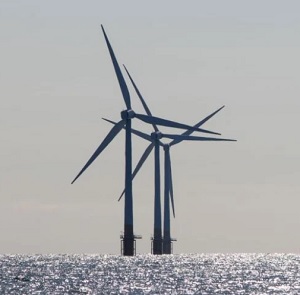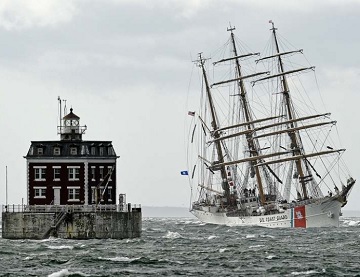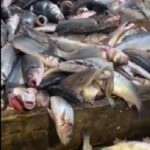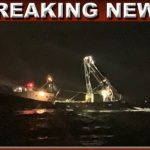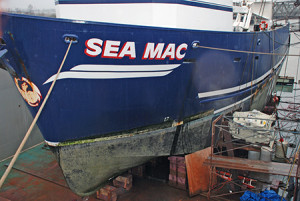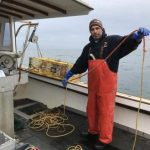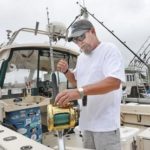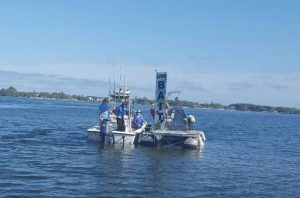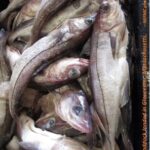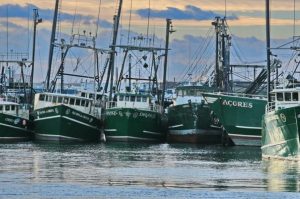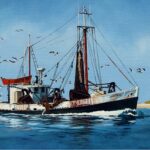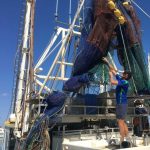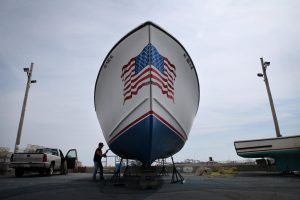Tag Archives: United States

U.S. announces reduced East Coast commercial mackerel quota for 2023
The United States will proceed with a commercial fishery of the depleted East Coast mackerel stock it shares with Canada in 2023. The U.S. quota was released this week, putting pressure on Canada which has yet to decide whether it will continue a total moratorium it imposed in 2022 to help rebuild the population. The National Oceanic and Atmospheric Administration, the U.S. equivalent of the Fisheries and Oceans Canada (DFO), announced on Tuesday a total allowable catch of 3,639 metric tonnes. It was 27 per cent cut from 2022 in recognition that the transboundary stock remains in trouble and is overfished. >click to read< 19:01
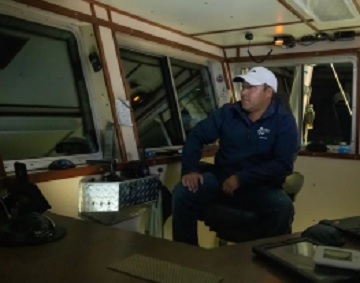
How new fishing technology could help save North Atlantic right whales
Captain Martin Noel and his crew have returned to the fishing grounds to retrieve their crab traps from the Gulf of St. Lawrence, about 140 kilometres off Shippagan, N.B. At the press of a button on Noel’s smartphone, an acoustic signal from a floating transducer pings an oxygen tank at the bottom of the ocean. That cues the tank to inflate a buoy, in turn, sending to the surface a line of traps from 300 feet below. Brimming with one of Canada’s most lucrative seafood catches, snow crab, these on-demand traps are pivotal to Canada’s plans to protect one of the world’s most critically endangered populations of large whales. >click to read< 10:06
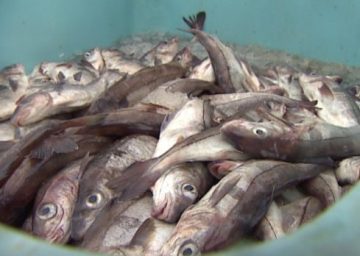
Canada, U.S. fail to reach agreement on quota for shared haddock stock in 2023
Canada and the United States have, for the first time, failed to agree on a shared quota for the transboundary haddock stock on the Georges Bank fishing grounds off southern Nova Scotia. The two countries have jointly managed the haddock fishery and two other straddling stocks, since 2000, but were unable to reach a consensus for the 2023 haddock quota. “While Canada and the U.S. tried to negotiate a shared haddock total allowable catch … our countries will be setting our own total allowable catch independently of the other,” The disagreement centred on the size of the quota cut. >click to read< 07:25

Fisheries minister pushes for joint Canada-U.S. management of depleted Atlantic mackerel stock
“We don’t support the fact that we had closures because the stock was in critical condition and the United States were fishing essentially that same stock,” Canada’s Fisheries and Oceans Minister Joyce Murray told a parliamentary committee Friday. Murray’s remarks are a more public stance on what has been a quiet effort by Canada to persuade the United States to jointly manage a species both countries say is in trouble. Murray said she expressed her concerns in a virtual meeting earlier on Dec. 2 with her U.S. counterpart, Richard Spinrad, who leads the National Oceanic and Atmospheric Administration or NOAA. “He wants to invoke the precautionary principle, which in my view, wasn’t happening adequately. We agreed that we share our approach to this and in two months there will be meetings between NOAA and DFO to discuss our assessments and build a better approach to rebuilding mackerel.” >click to read< 10:03
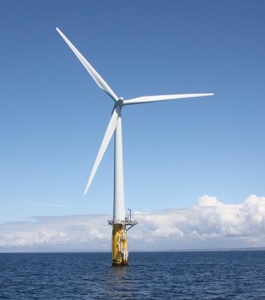
The great US offshore wind-power boom has begun to falter
Plans for massive offshore wind farms that President Joe Biden hopes will power as many as 10 million American homes by 2030 are starting to wobble. On Monday, New Jersey utility Public Service Enterprise Group Inc. said it’s deciding whether to pull out of Ocean Wind 1, a proposed project in the Atlantic Ocean that would generate 1.1 gigawatts – enough for 500,000 homes. Less than two weeks earlier, New England utility Avangrid Inc. said its similarly sized Commonwealth Wind project was no longer viable because of higher costs and supply chain woes. Offshore wind projects are “facing a number of headwinds,” Soaring inflation, rising interest rates and supply chain snarls around the world are threatening to hobble the offshore wind boom that both federal and local policy makers have been planning for years off the US East Coast. >click to read< 13:28

North Atlantic right whale’s decline slows, but population falls again
The decline of an endangered species of whale slowed last year, as it lost about 2% of its population, but scientists warn the animal still faces existential threats and is losing breeding females too fast. The North Atlantic right whale’s population was more than 480 in 2010 and fell by more than 25% over the following decade. The North Atlantic Right Whale Consortium, a group of scientists, government officials and industry members, said Monday that the population fell to an estimated 340 last year. That is a decline of eight animals from the previous year, when the population was initially thought to be even fewer. >click to read< Meanwhile in Canada, no right whale deaths have been reported in Canadian waters in three years. >click to read< 08:02
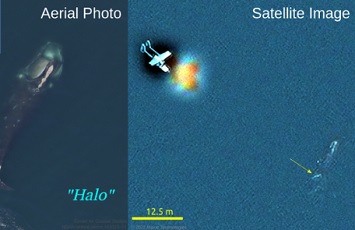
New satellite imagery first to identify North Atlantic right whale from space
New satellite imagery research led by the University of Ottawa is the first to identify a specific endangered Gulf of St. Lawrence North Atlantic right whale from space. Matus Hodul: “The North Atlantic right whale is critically endangered, with about 336 individual whales accounted for. Mortality comes from whales being hit by ships and becoming entangled in fishing gear, so being able to detect and monitor their location is important to conservation efforts. Knowing where the whales are at any given time enables fisheries to open or close to avoid the whales and enables ships to bypass them to prevent collisions.” >click to read< 07:46 ‘Individual North Atlantic right whales identified from space’ >click<
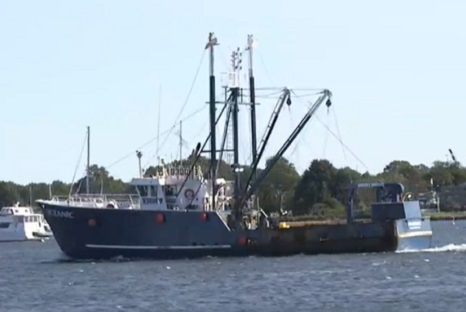
The U.S. is not harvesting as many fish as it could, driving up imports
In 2020, the global fishing industry reached an all-time record of production worth an estimated $406 billion, according to the Food and Agriculture Organization of the United Nations. Fish is a key source of protein, making it essential in feeding the growing world population. In the United States, New Bedford, Massachusetts, is the country’s most valuable fishing port, bringing in a whopping $376.6 million worth of seafood in 2020. “Fishing stocks did have a collapse in the ’90s. It changed the species that we were offering. It changed the availability. It changed the pricing,” Laura Foley Ramsden, fourth generation “fish mongress” of Foley Fish in New Bedford, 15-minute video, >click to read< 09:52
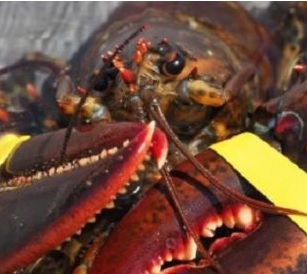
ENGO recommends against consuming lobster over danger to whales
Seafood Watch, a program out of the Monterey Bay Aquarium, says entanglement in fishing gear is the leading cause of death of the critically endangered North Atlantic right whale population, and US and Canadian lobster fisheries aren’t doing enough to prevent it. Jennifer Dianto Kemmerly is vice president of global ocean conservation at the Aquarium. “We really want consumers and businesses to be aware of how dire the situation is,” Kemmerly said. Meanwhile, the international conservation group Oceana blamed the National Marine Fisheries Service for failing to update safeguards that would protect both right whales and lobster fisheries. To remove the red listing, it recommends using ropeless gear, expanding seasonal closures where whales are present, and improving transparency and monitoring of fishing vessels. >click to read< 18:11
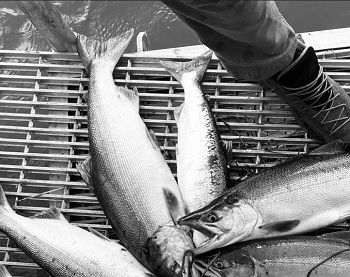
B.C. fishermen fume as their Americans counterparts fish
Commercial salmon fishers and environmentalists are crying foul, for opposite reasons after U.S. fisheries officials let American fishers hit the water while the Canadian government kept their counterparts ashore. After several years of historically low runs, the Pacific Salmon Commission (PSC), an international fisheries management organization, estimated last week that enough sockeye, about 4.4 million, would return to the Fraser River to support a commercial fishery. American fisheries managers adopted the commission’s estimate, opening a small commercial fishing window over the weekend. But in a rare disagreement, Canadian officials did not, citing concerns the run would be nearly one million fish smaller than predicted, and kept Canada’s waters closed. >click to read< 10:16
Concern for BC sockeye salmon as return estimates drop by millions – The Pacific Salmon Commission’s pre-season estimate of 9.8 million returning fish went down to 5.5 million Monday, prompting environmentalists and fishers alike to express concern. >click to read<

N.L. MP vows he’s ‘gonna keep pushing’ forward on seal management legislation
Clifford Small may have lost a battle in his bid to convince the House of Commons of the need for legislation to manage seal populations, but the Newfoundland and Labrador Conservative MP says he’s not about to give up the fight. Small’s private members’ bill, Act for the Conservation of Fish Stocks and Management of Pinnipeds (seals), or Bill C-251, died when it came to the House for second reading on June 15. There’s more than one way to move a bill through the parliamentary process, said Small. Bills can start in the House or they can be introduced through the Senate, he said, indicating that’s the path he may pursue next. >click to read< 14:20
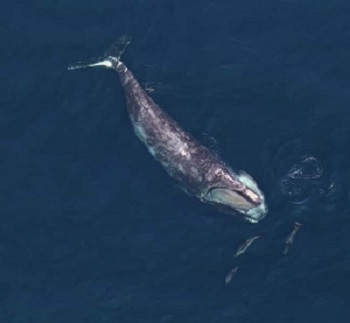
North Atlantic Right Whale: Oceana Wins First Step In USMCA Complaint
The Secretariat for the Commission for Environmental Cooperation, part of the United States-Mexico-Canada Agreement (USMCA), has agreed to move forward with the first step in a two-step process to investigate the USA’s failure to uphold its environmental laws to protect North Atlantic right whales, according to an Oceana announcement this week. The decision was in response to Oceana’s filing the first-ever “Submission on Enforcement Matters” against the US government under the USMCA last October. The ocean advocacy organization claimed the government has violated the USMCA by failing to enforce environmental laws to protect critically endangered North Atlantic right whales, of which only around 330 remain. >click to read< 14:53

Why every American should care that diesel prices are surging across the country
To many Americans, including politicians, diesel prices are so removed from their version of reality that they often dismiss the importance of diesel to the U.S. and global economies. Today’s truckstop retail diesel prices hit a new record of $5.32/gallon. However, diesel is the fuel that drives the economy and leaves major industries vulnerable to cost shocks. Without diesel fuel, the U.S. economy would collapse in a matter of days. Our supply chains would completely shrivel, almost overnight. Trucks use it to haul our goods across the country. Of all Class 8 trucks (the big ones), 97% use diesel. A world without diesel would mean that our grocery stores and restaurants would run out of food, retail store shelves would be empty, and hospitals would run out of medical supplies. But that is just scratching the surface. Farmers use diesel to power most of their machinery. Nearly every fishing vessel around the world uses diesel for power. Without diesel, our fishing food supply chain would collapse. >click to read< 17:39
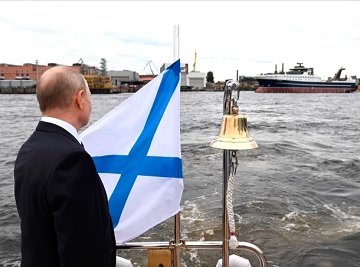
Despite war ban, Russian seafood could enter the US anyway
Fishing is big business in Russia, one closely linked to the Kremlin and President Vladimir Putin’s projection of power at sea. The country is one of the world’s top seafood producers and was the eighth-largest exporter to the United States last year, with more than $1.2bn worth of sales, the bulk of it king crab. But it is unknown exactly how much manages to land in the US by way of China, which sent another $1.7bn in fish to the US last year. Nor does the Biden administration’s ban require companies importing from China to find out. But the same species is also harvested in Russia in similar amounts, and once processed and imported from China, fills an important gap in the US market. In lieu of tracing the country of origin, US producers rely on the name recognition of Alaska pollock to signal where the fish was caught. >click to read< 17:31
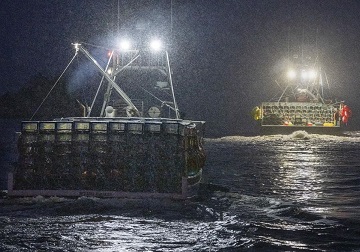
The value of Canadian lobster exports has skyrocketed driving the wharf price toward a record high
Two weeks ago, at wharfs in Nova Scotia, the price of lobster was the highest it has ever been. Stewart Lamont, managing director of Tangier Lobster Company, a live lobster exporter in Nova Scotia, said the shore price for lobster, the amount fishermen get from buyers, was $18 a pound. That’s more than double the regular pre-pandemic price. It has since gone down due to a drop in exports and higher supply. Lamont said this week lobster was around $12 to $12.50 a pound. While high prices mean more money for lobster exporters and fishermen, Lamont said he is scared that if lobster becomes too expensive, people and businesses will simply stop buying it. >click to read< 10:52

The Clean Water Act, passed into law 50 years ago, has fallen well short of its goals
Nearly half of the rivers and streams across the U.S. are considered too polluted to meet quality standards for swimming, recreation, aquatic life, fish consumption or as drinking water sources. The Environmental Integrity Project, a nonpartisan nonprofit formed by former Environmental Protection Agency attorneys, published a report that found alarming results of water quality tests in all 50 states. More than 700,000 miles of waterways, about 51 percent of assessed river and stream miles, are impaired by pollution. That’s in addition to another 55 percent of lake acres and 26 percent of estuary miles. >click to read< 16:49

U.S. Bans Russian Seafood, Alcohol in Downgrade of Russia’s Trade Status
The United States will join the European Union and Group of Seven (G7) countries in downgrading Russia’s “most favored nation” trade status, President Joe Biden announced Friday. As part of a new executive order from Biden, the administration will also ban alcohol, seafood and diamonds from Russia in response to its invasion of Ukraine, which is currently in its third week. The move is part of a series of actions by the U.S. and Western nations to chip away at Russia’s economy through sanctions and bans. >click to read< 11:15

Despite Ukraine invasion, the U.S. and Russia are still working together to solve salmon mysteries
Tensions continue to simmer between Moscow and Washington in the wake of Russia’s invasion of Ukraine. In many respects, the divide between East and West is deepening: Oil companies are canceling partnerships with Russian firms. State legislators are calling for the state’s sovereign wealth fund to dump Russian investments. President Joe Biden announced Tuesday the U.S. would close its airspace to Russian aircraft. But the United States and Russia are continuing to work together on at least one issue: salmon. >click to read< 10:10

Canadian lobster exports have biggest year ever, topping $3.2B last year
The value of Canadian lobster exports topped $3.2 billion last year, the highest ever and more than $700 million higher than pre-pandemic levels, according to new trade data. Soaring sales of Canadian frozen and processed lobster in the United States during 2021 accounted for most of the increase. “We had a very strong bounce back from the pandemic as people ate premium protein that they bought in grocery stores. They wanted healthy food, they wanted safe food and they wanted a treat. So they buy lobster,” said Geoff Irvine, executive director of the Lobster Council of Canada, an industry trade group. >click to read< 07:57

Ghost of seal hunt haunts Canadian trucker blockades over COVID-19 testing
Canadian cattle and pigs fed grain from the United States are going hungry. Some cattle and pigs en route from Canada to finishing and slaughter in the U.S. may be stuck aboard trucks. Behind the chaos lurks the ghosts of past political impasses over cod fishing quotas and the Atlantic Canadian seal hunt. What the long depleted Atlantic Canadian cod stocks and the nearly moribund seal hunt have to do with horn-honking truckers, cattle and pigs mooing and oinking with hunger pangs, and widespread public and political exasperation,,, You see where this is going, eh? >click to read< 19:36

U.S. lobster set to feed another Chinese New Year as demand booms
The week-long holiday, commonly known as the Spring Festival or the Lunar New Year, is typically one of the busiest times for the U.S. lobster business. Appetite for the crustaceans remains strong in China this year, despite pandemic-related challenges to transportation and logistics, according to U.S. lobster industry members. “I have orders every day. Whether I can get them all on the airplanes every day becomes a question,” Bill Bruns, operations manager at The Lobster Co. >click to read< 08:16
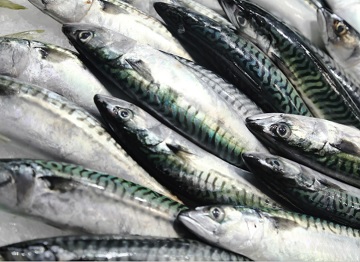
Where Did All the Mackerel Go?
Summer in Atlantic Canada can be unreliable, emerging reluctantly from the damp cold of spring. But a sure sign of its arrival is the sudden presence of Atlantic Mackerel, Slipping away is already something of a mackerel specialty as they dart from their winter habitat, in the deep water along the continental shelf stretching from Nova Scotia to North Carolina, to their inshore summer spawning grounds. For the so-called northern contingent, from which the Canadian catch is derived, these spawning grounds are in the Gulf of Saint Lawrence; for their southern counterparts, summer is spent on the mid-Atlantic coast up to the Gulf of Maine. >click to read< 09:55
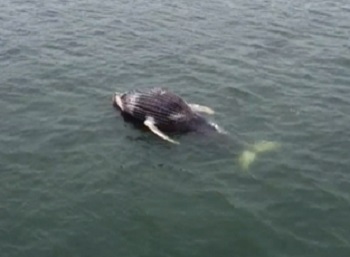
COVID-19 saves right whales by sinking cruise ships
Canada created the Shediac ship restricted zone in April 2020 just a couple weeks before Holland America’s Zaandam was scheduled to sail through that zone on a shipping lane used only seasonally by cruise ships as a shortcut to Quebec City. However, a COVID-19 no-sail order in March 2020 superseded that restriction. Consequently, there was not one Canadian ship right whale strike death in two years and only one Canadian crab entanglement death,,, Zero whales were killed by lobster gear. There has not been one death from lobster gear in the U.S. and only a couple in Canada in over 20 years but the Center for Biological Diversity, with no supporting data, claims the whales are going extinct based on lobster entanglements. >click to read< By Jim O’Connell 07:31
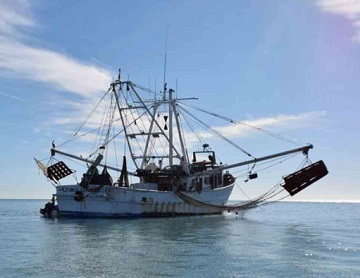
U.S. puts restrictions on Mexican boats over illegal fishing
The U.S. government is putting restrictions on Mexican fishing boats entering U.S. ports over allegations that the Mexican government has failed to prevent illegal fishing in U.S. waters. Starting Feb. 7, all Mexican fishing boats in the Gulf of Mexico will be prohibited from entering U.S. ports. “This is an example of how rampant illegal fishing is in Mexico,” said Alejandro Olivera with the Center for Biological Diversity. “Mexican fisheries enforcement has been weakened since the start of this administration.” >click to read< 09:50
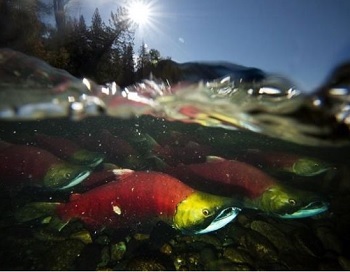
Alaskan fishing fleet catching huge proportion of B.C. salmon
As salmon runs in British Columbia hit record lows, commercial fisheries along the Alaska panhandle are catching a growing share of salmon bound for B.C. rivers, according to a new technical report. The report, which includes a detailed analysis on each B.C. salmon species caught in Southeast Alaskan interception fisheries, was commissioned by Watershed Watch Salmon Society and SkeenaWild Conservation Trust and comes as Canada and the United States begin their annual review of bilateral management under the Pacific Salmon Treaty. Many of B.C.’s largest salmon runs pass through Alaskan waters on their way home to spawn in Canadian rivers. >click to read< 11:50

NOAA/DFO Officials on Risk Reduction and Protections for North Atlantic Right Whales
In December, NOAA Fisheries held another productive biannual engagement with officials from the Department of Fisheries and Oceans Canada to discuss ongoing efforts by both countries to protect and recover North Atlantic right whales,,, While this was the last of the 2021 biannual meetings with Canada on this topic, it was my first as the Assistant Administrator for Fisheries. Both of our countries face the same challenge >click to read<,-Read about her background, >click here< 10:53
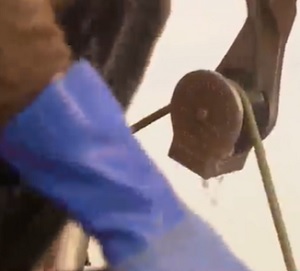
DFO Policy Puts Harvester Lives and Livelihoods at Risk
A new ‘weak rope’ gear policy being implemented in Newfoundland and Labrador will have negative implications for fish harvesters in this province, including risks to safety, an unknown cost burden, and significant potential for increased environmental waste. Weak rope measures are being implemented with the goal of preventing right whale entanglements. While these entanglements may be a concern for fisheries in Nova Scotia and New Brunswick, there has never been a right whale entanglement in the Newfoundland and Labrador fishery.,, “The death of one right whale could have a disastrous impact on seafood exports to the United States. Fish harvesters know this and will gladly take all reasonable steps to protect the species and their livelihoods but implementing this policy without any due diligence is entirely unreasonable,” >click to read< 10:55
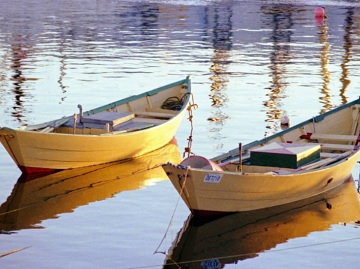
How Grand Bank made the ‘Grandy dory’ a Newfoundland icon
During the late 1800s and all of the 1900s, the small boat of choice along the south and southwest coasts of Newfoundland and Labrador was the dory.,, Simeon Lowell of Salisbury Point, Mass., is credited with inventing the dory in 1793. Over the ensuing decades these small, shallow draft, flat bottom boats measuring five to seven metres long, became so popular and were in such demand for fishing along the eastern seaboard that eventually “dory factories,” where they were mass-produced, were established. Around the same time schooners from Nova Scotia also took advantage of the lucrative fishing on our offshore banks followed by our own fishermen in 1891, led by Samuel Harris and at least 16 other schooner owners from Grand Bank. photos >click to read< 11:28






